Win Big with Maisto & BBurago! 16 Jan 2024 5:58 AM (last year)
Enter Now to Win Exclusive Maisto & BBurago Diecast Models!
The post Win Big with Maisto & BBurago! appeared first on Die Cast X.
Kyosho Lexus LX570: Lavishly detailed luxury Land Cruiser 10 Feb 2021 8:25 AM (4 years ago)
You have to squint pretty hard to see the Toyota FJ roots beneath the slick exterior of the modern-day Lexus LX series SUV. The earliest FJs were two-door utilitarian off-roaders—quite literally Japanese knock-offs of the original Jeep CJ—and by the 1960s Toyota’s signature 4×4 had developed quite a following both for its reliability and for its terrain-conquering prowess. But for all their strengths, two things those FJs were not were roomy and comfortable, so in 1963—in response to growing demand in the USA and elsewhere—Toyota added a long-wheelbase 4-door version of the iconic FJ40 Land Cruiser dubbed the FJ45. In 1967 that evolved into its own distinct model, the FJ55—a homely but nigh indestructible wagon that came to be nicknamed the “Iron Pig.”
At a Glance
Model: Lexus LX570
Manufacturer: Kyosho
Genre: Modern Luxury SUV
Scale: 1:18
Item no. K08955SBK
Price: $180
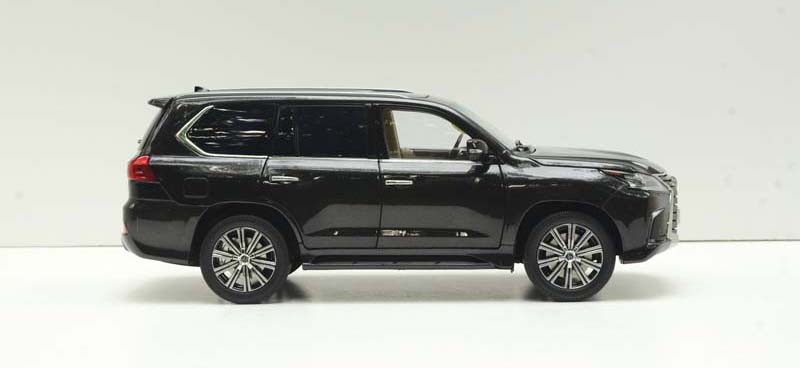

Offering seating for up to seven and in more comfort than preceding models, the FJ55 can be described as Toyota’s first “luxury” SUV, although its interiors were pretty spartan by today’s standards and it retained superior all-terrain capability. The FJ55 evolved into the FJ60 series in 1980 and then into the FJ80 in 1990, each adding successively more creature comforts. A huge bump in power arrived in 1992 when the aging F-series OHV Inline-6 was replaced by the new DOHC FZ (thereby dropping the “F” from the J80 designation). In 1995 Toyota finally fully embraced the concept of the luxury SUV by introducing a version of the J80 for its North American prestige nameplate Lexus called the LX450.
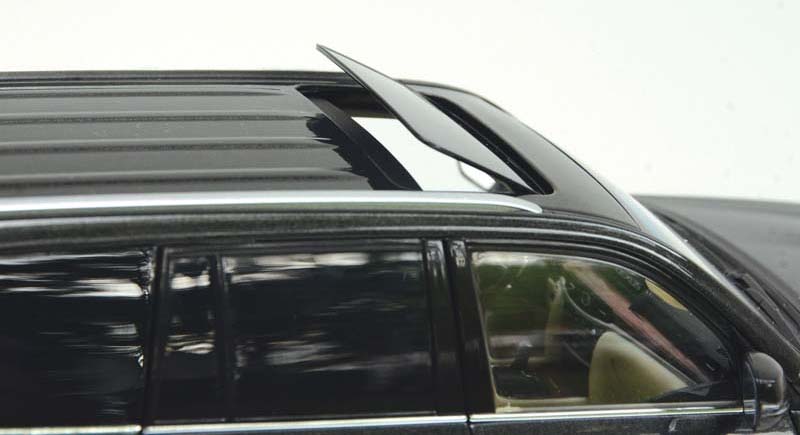
Kyosho has engineered numerous opening panels into the LX570: all four doors, the split tailgate, and even the sunroof!
The LX is hugely profitable, so Toyota has made it a priority to co-develop a Lexus version of each J-series SUV (the J100 in 1998 and the J200 in 2007) since. The latter underpins the flagship LX model you see here—the LX570. The LX570 got a mid-cycle freshening in 2016 and Kyosho’s model represents the facelifted version which added the huge spindle-shaped grille that Lexus now uses across its entire vehicle line. That gaping maw is a love/hate look for some, but the beefy LX wears it well and Kyosho has certainly nailed the look with admirable precision. The body is metal, and the Star Light Black paint is lovely with subtle metalflake providing the starry twinkle. The chrome brightwork is rendered with individually cast metal pieces as well, in the front fascia and window trim. There are cool little extras like folding mirrors which both protect the model during shipping and add a little realism.
You can bet a $95K SUV is going to be nice inside, and sure enough the interior is the highlight of the LX570—both in reality and in scale. Kyosho really shows its ingenuity here. The expected upscale touches are included: hidden hinges, carpeted floors, satin-finish surfaces replicating leather. The dash, console, and center stack all have excellent detail with their instruments, switchgear and simulated wood trim. All four doors open, as does the split tailgate. But the LX also features a functional sunroof complete with a sliding sun shade beneath! And it gets better. When you open the tailgate you see the optional third-row seating in the back of the LX570, but don’t just see them. Reach out and touch them. Specifically, fold the headrests forward, then the seat backs, then flip each seat 90-degrees outward and they fold away just like in the real LX570! That is simply awesome engineering in 1:18 scale.
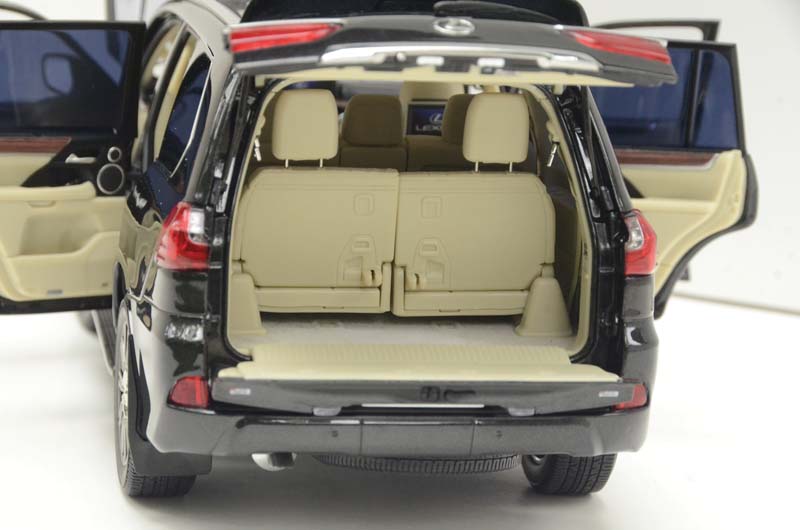
The model’s highlight is the functional folding third-row seat which folds forward and then to the sides, just as in the full-size LX570.
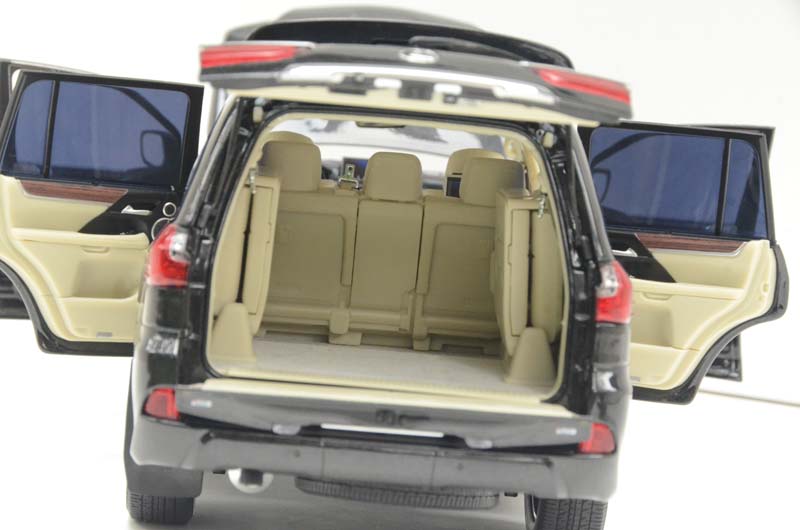
The “570” in the name refers to Toyota’s DOHC 5.7L V-8 which the LX shares with the Land Cruiser and Tundra series pickups. It makes 383 horses, which is enough to move the 6200-pound Lexus confidently, but this vehicle will never be confused with a hot rod. The motor plate beneath the hood is standard fare for this type of model; what you see is pretty much what you’d see under the real LX’s hood since its motor is covered in a plastic shroud painted metallic silver. The model adds a bit of detail for the air box, fluid reservoir, and some plumbing, but there’s not a lot else to see.
Mechanical detail on the chassis is a bit more interesting. The live axle/trailing arm rear suspension is old school and in full view as are the lower control arms for the independent front, although the rest is hidden under a belly pan/skid plate. The LX570 includes dialable ride height adjustment; the model’s stance depicts the default height, which is still pretty high for a luxury SUV. It rides on some serious 20-inch 10-spoke rims and relatively nondescript all-season tires, a sure indicator that Lexus expects few LX570s ever see off-road use.
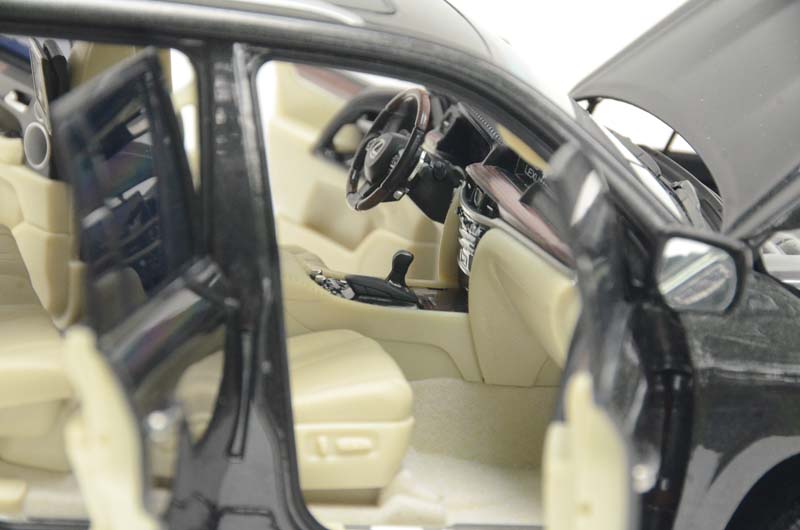
Luxury SUVs are all about interior quality and Kyosho delivers plenty in its 1:18 version.
What we like
+ Interior is loaded with innovative functional features
+Paint and cast chrome trim yield superior fit and finish
+Substantial model with substantial presence
FINAL THOUGHTS
Luxury SUVs may seem an unusual choice for diecast, but Kyosho has been doing them—and well!—for a long time and understands that the demand is there. Seeing the clever engineering that went into this LX570 should convert even more fans to the genre. The metal body and fine fit and finish present well, but the real treat lies inside with some unusual functional features. In short, this tall SUV offers collectors a lot for the money.
SOURCE
Kyosho.com; distributed by acmediecast.com
The post Kyosho Lexus LX570: Lavishly detailed luxury Land Cruiser appeared first on Die Cast X.
Hot Wheels Flashback: 1973 – Super rare, Superfine Turbine! 10 Feb 2021 8:18 AM (4 years ago)
The year 1973 was pivotal for Mattel and the Hot Wheels brand. Sales were slowing and production costs were climbing; Mattel had to figure out how to keep the Hot Wheels line profitable. First, they changed the paint from the shiny candy-type Spectraflame to drab, unflattering enamel colors. Changing to enamel saved processing steps which, in turn, saved time and money. Two-piece wheels were phased out in favor of a one-piece design with an open center. Plastic parts, such as wings and engines, were done away with, as were stickers. Fewer parts meant fewer hands on the product, which equated to less assembly cost. Of the 24 Hot Wheels vehicles released for 1973, only three were new castings. The remaining 21 were recycled castings from previous years, again saving production costs by only having to invest in three new molds. The new castings for the 1973 line were the Double Header, the Sweet 16, and the Superfine Turbine. Interestingly, none of those three new castings were ever seen in mainline production again!

Theodore N. Gray owns the most extensive collection of Mexican-market Turbines and is the recognized authority on CIPSA cars. He has literally written the book on the subject. You can pick up a copy at cipsacars.com.
Maybe it was the plain, less-than-flattering colors, or the rehashed castings with missing parts, but for whatever reason, Hot Wheels did not sell as well as Mattel would have liked in 1973. Mattel even tried teaming up with the Shell Oil Company on a promotion: with the purchase of three dollars or more of Shell gasoline, customers were able to purchase one of 10 different Hot Wheels cars for just 69 cents each. The promotion did well for Shell gas stations, but ultimately it did not increase the overall sales of Hot Wheels by much. Lower sales equates to lower production, making the 1973 cars hard to come by; the three produced only for 1973 are among the hardest to find and, consequently, some of the most expensive Hot Wheels to collect.
The rarest and most valuable of the three models is the Superfine Turbine, which was painted in six colors for the 1973 Hot Wheels mainline: dark blue, light blue, lime green, lemon yellow, red, and pink. All are in the $400 to $500 range for mint condition cars, except for the pink, which is valued at $2,000. Packaged examples are valued at much more, depending on color and package condition.

The only known full card CIPSA Hot Wheels Car.

The CIPSA Superfine Turbines exclusive to Mexico came in four unique colors, and are among the rarest Hot Wheels of all time

The original scale design was worked out on a hand-carved, oversized wood buck. The design was then translated to a hand-carved 1/64 scale prototype for approval.

The Superfine Turbine was also produced in four different enamel colors exclusively for the Mexican market. Those colors are: orange, brown, mustard yellow, and bright green. These Mexican-market Hot Wheels were Mattel-licensed and assembled in Mexico by the CIPSA Company. CIPSA Hot Wheels cars and accessories are extremely rare and very pricey! So rare in fact, that there is only one CIPSA-carded Hot Wheels car known to exist—a yellow Superfine Turbine belonging to a collector named Theodore N. Gray. He has amassed the most complete collection of the Superfine Turbine, including the CIPSA colors and many other pieces, such as prototypes and model bucks you see on these pages. He has also collected and documented the CIPSA Hot Wheels line, and has recently published a book about the CIPSA Hot Wheels story. If you are an avid Hot Wheels collector who just can’t get enough history and background information, I recommend buying his book from cipsacars.com. In fact, all of the photos in this article are courtesy of Theodore Gray.
Author: Mike Zarnock | Photos courtesy of Theodore Gray
The post Hot Wheels Flashback: 1973 – Super rare, Superfine Turbine! appeared first on Die Cast X.
The ’55 Chevy Gasser is not slowing down 10 Feb 2021 8:13 AM (4 years ago)
It seems the old adage “The more things change, the more they stay the same” still rings true, especially for the Hot Wheels `55 Chevy Gasser! The Gasser has been in the spotlight continuously from the moment it was released, and it shows no sign of slowing down. First released in 2013, this high-riding 1955 Chevy Bel Air was designed by Brendon Vetuskey. If you don’t know of Brendon, he’s like most Hot Wheels designers—a car guy through and through. You may have seen his highly modified bare-metal street/track 1969 Pontiac Firebird on the cover of Car Craft magazine, and possibly on the shelves in stores around the world as a Hot Wheels car. Brendon loves American muscle and has a special fondness for the nose-in-the-air cars that ran in the “Gas Class” at drag strips across the country from the 1950s through the 1970s.
Gassers, as they’re known, typically have a straight axle under the front end connected to the chassis with leaf springs instead of the normal independent suspension. It made them look very strange, but drag racers figured out that bringing the front end up high changes the car’s center of gravity, transferring more weight to the rear under acceleration and giving them better traction. Some of the earlier cars in the gasser class were pre-war 1939-41 Willys coupes and others from that era with similar body styles, but as time went on and the old coupes became harder to find racers started building them out of anything they could. And what better subject than the `55 Chevy? Oh, and by the way—Brendon is building one of them too!
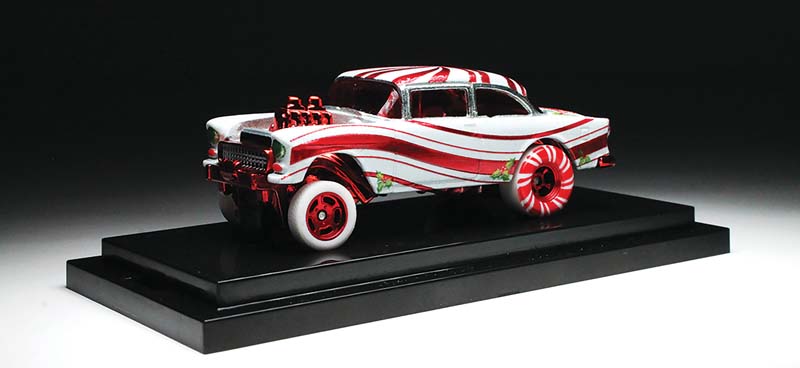
Mattel Employee Association Dinner Dance Car was a limited run of 425 pieces given only to Mattel employees. They have sold for as much as $2400 on the secondary market!
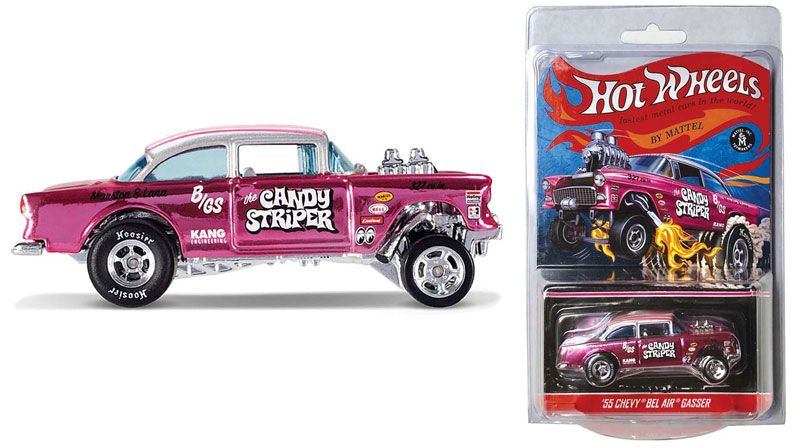
The Candy Striper `55 Chevy Gasser release from Hot Wheels is highly sought-after, fetching as much as $1500 by collectors. The packaging art is just a cool as the car itself!
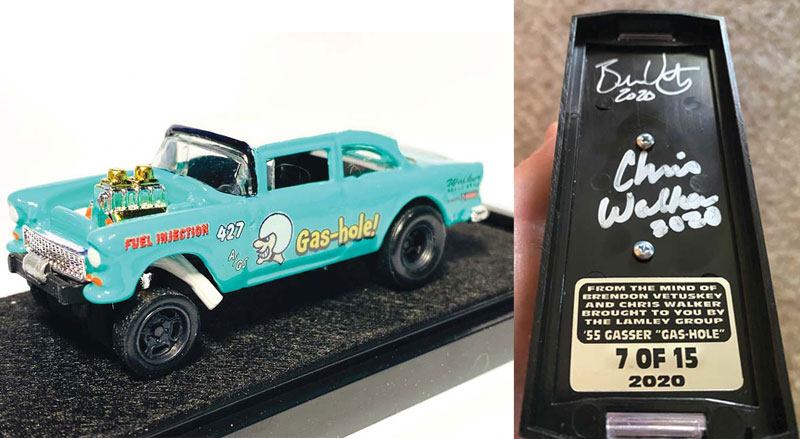
Just 15 of the custom `55 Chevy Gasser called “Gas- Hole” were produced by Chris Walker of Night Stalker Customs for the “Make A Wish” charity using graphics designed by Brendon Vetuskey. Both men signed the base of each car, and they have sold for as much as $2000 each!
There have been more than 30 different versions of the `55 Chevy Gasser released by Hot Wheels in the past seven years—either in the main-line series (including Treasure Hunts), special edition sub-series like Pearl & Chrome, Red Line Club, Premium series like Car Culture, plus several Employee Dinner gifts and Convention Cars. They’ve also become fodder for many Hot Wheels customizers who take them apart and redo them in many different configurations. As with most high-demand Hot Wheels cars, the limited-number releases have come to command some big money! Of course the annual MEA (Mattel Employees Association) Dinner Dance car is the most exclusive and expensive at around $2400. Produced in white and red with a production run of just 425 pieces that were only given out to Mattel employees it is the most valuable to any collector, in my opinion. Another highly desirable release is the “Gas-Hole” `55 Chevy Gasser that was produced as a custom for the “Make A Wish” charity, with special graphics designed by Brendon. These cars were produced in an extremely low number of just 15 pieces by Chris Walker of Night Stalker Customs and have sold for as much as $2000 each.
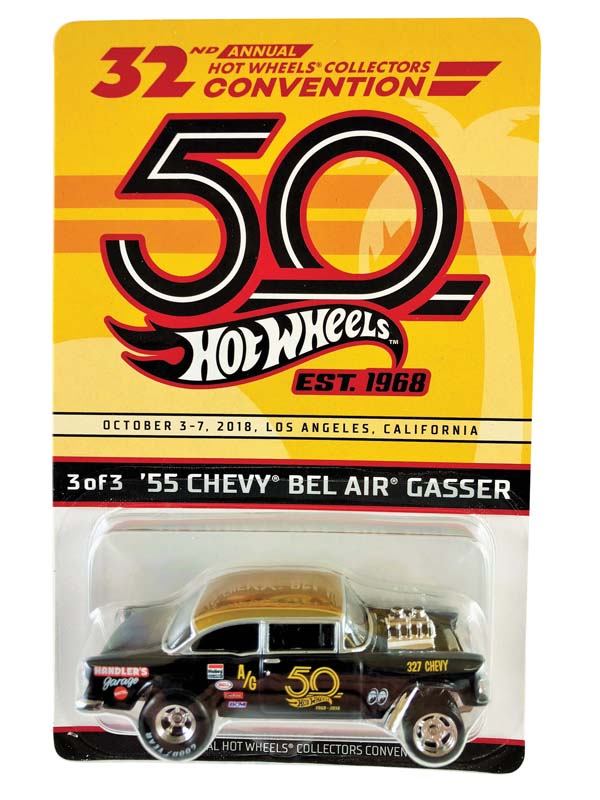
One of the 2018 Hot Wheels Convention cars was a black and gold `55 Chevy Gasser sporting the 50th Anniversary of Hot Wheels logo on it!
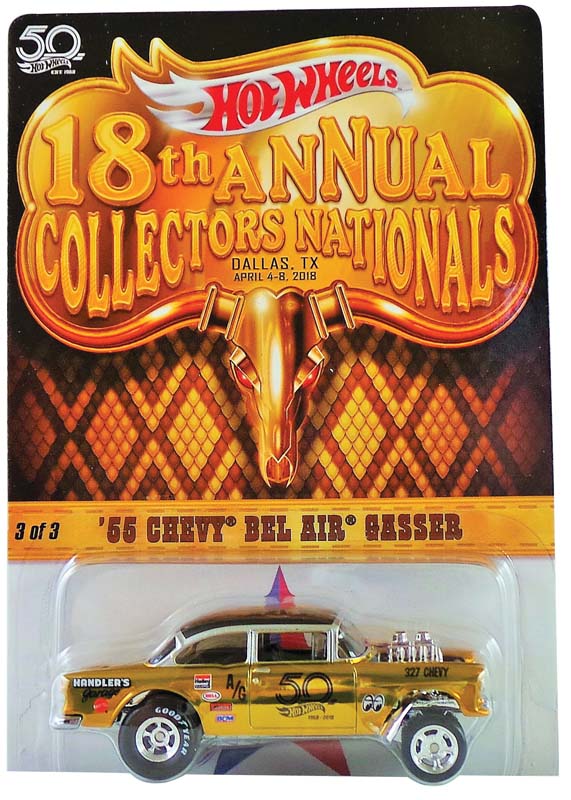
Keeping with the 50th Anniversary theme, the 2018 Hot Wheels Nationals Finale car was done in opposite colors from the 2018 Convention car, with the body in gold and the roof in black.
The Hot Wheels Convention and Hot Wheels Nationals releases are also in demand, but the prices are a bit odd considering the production numbers. The 2017 Hot Wheels Nationals “Wicked Gasser” in red had a production run of 2800, the 2018 Hot Wheels Nationals “50th Anniversary Gasser” in gold has a run of 3500 made, and both of these cars can command prices up to $250. Compare that to the 2014 “Candy Striper” in pink which had a production run of 4000, yet it has sold for as much as $1500 on the secondary market! I will just never understand what collectors want and what they are willing to pay! All in all the Hot Wheels ’55 Chevy Gasser is a very nice nostalgic piece to have in your collection, no matter which configuration you’re able to afford!
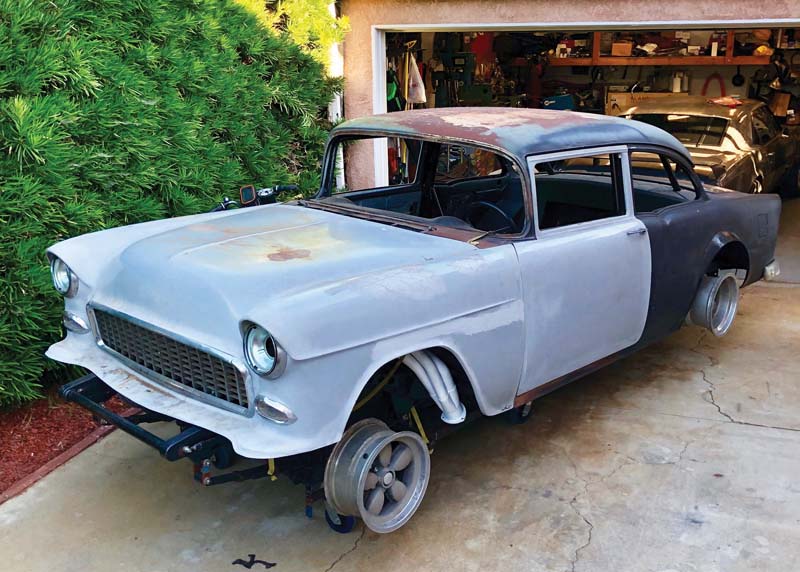
Brendon Vetuskey has been building his very own real-life version of the `55 Chevy Gasser for a couple years now.
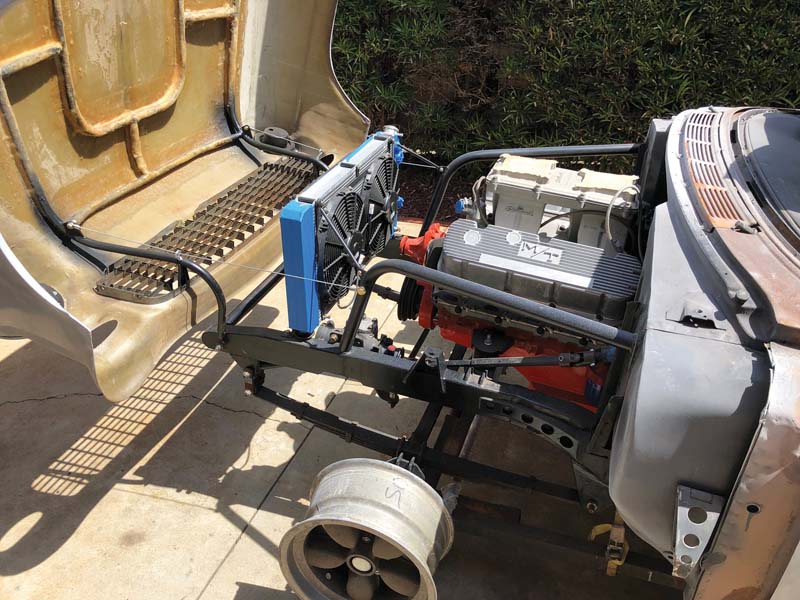
by Mike Zarnock
Photos by BrendOn Vetuskey, Chris Walker, and courtesy of Mattel
The post The ’55 Chevy Gasser is not slowing down appeared first on Die Cast X.
GT Spirit Porsche 911 (964) Speedster Turbo 10 Feb 2021 8:09 AM (4 years ago)
The name “Speedster” is so widely renowned and universally beloved among Porschephiles that it is easy to forget that it’s only actually appeared on half a dozen vehicles in the company’s history. The first official Speedster arrived in 1954 as a variant of the 356 Cabriolet. Its interior was stripped of any superfluous luxury items (including side windows!) and had only a minimalist folding top. But its signature feature was the special shortened windshield that could be removed altogether for racing purposes. The 356 Speedster continued through the ’58 model year before exiting the Porsche lineup for the next 31 years!
At a Glance
Model: Porsche 911 (964) Speedster Turbo-Look
Manufacturer: GT Spirit
Genre: Late model sports car
Scale: 1:18
Price: $140
What we like
+ Ultra-rare provenance of a Sonderwunsch Speedster
+ Crisp sheen of the Polar Silver paint accents the car’s curves perfectly
+ Excellent wheel and tire detail
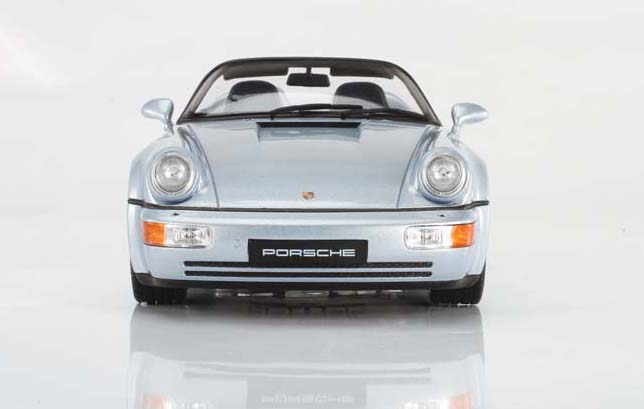
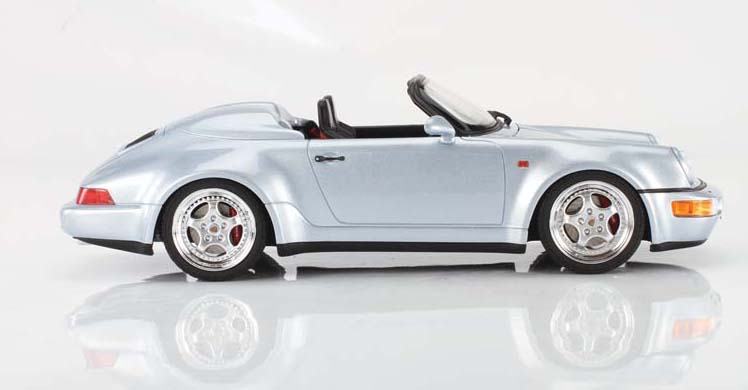
The Speedster designation would make its return in 1989 for a final-year sendoff of the first-generation 911 “Classic.” This time, the transformation was more extensive. Using the Carrera Cabriolet as a jumping off point, Porsche again installed a lower, more steeply raked windshield in a lightweight aluminum frame that owners could remove (although few ever did), but this time they did not skimp on creature comforts. The Speedster shared the same interior appointments as all Carrera Cabriolet models with the exception of the rear seats (Speedsters had none). More dramatic even than the windscreen was the new double-hump rear tonneau cover which stretched over both the cargo shelf that replaced the rear seats and the manual folding top mechanism. Interestingly, Porsche chose to offer the Speedster in two body styles—the standard Carrera, and the “Turbo-look” with the wider rear fenders and tires from the Turbo model, but both of these were powered by the naturally aspirated Carrera 3.2L motor. Porsche offered the Turbo-look because the actual turbocharged model was not available for sale in the United States at that time, but the look-alike proved so popular that it outsold the standard narrow body by more than ten to one, despite being heavier and commanding a $7,000 price premium!
That brings us to the third Speedster. With the rousing success of the 1989 model, Porsche waited just four years to trot out a Speedster version of the Carrera 2 Cabriolet, built on the new 964 platform. The 1993 Speedster got the same windshield and humped-deck treatment as the ’89 model, but returned to the minimalist ethos of the original 356 by stripping out many of the luxury items to save weight. And curiously, despite overwhelming customer preference for the widebody in ’89, the decision was made to offer the 1993 version only on the narrow body. But so strident was the demand for a widebody that Porsche authorized its in-house custom shop in charge of the Sonderwunsch Programm (which translates literally to “Special Wish Program”) to convert a handful of Speedsters to widebody Turbo-look configuration for special customers. The exact number built is not clear; some sources say 15, while others say as many as 20. Either way, the ‘93 Turbo-look Speedster is among the rarest Porsches ever built, and the perfect subject for a GT Spirit 1:18 replica.
Like all GT Spirit models this is a sealed-body resin piece. It is delivered in Polar Silver Metallic, which has a beautifully crisp satin sheen to it; the color really accents the muscular compound curves across the tonneau humps and around those wide rear fenders, making the most of what makes this car something truly rare and special. Each of these Speedsters was essentially custom-built to order, so certain details vary from car to car; this one is a very clean, unembellished example without extra chin spoilers or ground effects that some received. The contours of the shortened windscreen are accurate, and the flat black, thin frame is correct as well. Little items, such as the raised lip of the heat extractor vent on the engine cover, show the excellent attention to detail.
As an open-top Speedster, the interior detail is on full display. This one is trimmed mostly in black, but there is a set of carbon-frame sport seats installed, which adds a splash of color: the seat insert panels add two shades of gray to contrast the black bolsters, and the rigid backs are decorated in a matte red. The instrument panel is a decal; there’s a brown surround that may be wood paneling, and the gauge faces have numerals detailed. The gear lever is stenciled with the shift pattern, and there are splashes of red paint on the e-brake handle and door pulls. Red fabric seatbelts with etched buckles are tucked into the side panels behind the seats.
Because the body is sealed, there is nothing of the 250 hp 3.6L flat-6 that was standard equipment for all Carrera 2s, even the ones wearing turbo duds! The chrome tip on the single outlet exhaust and the sculpted muffler immediately upstream of it are the only mechanical details evident on the power train side.
There is, however, quite a bit to see on the braking side. Metal cross-drilled rotors and bright red calipers with “Porsche” stenciled on them are clearly visible through the wheel spokes. A word on those wheels as well: the standard wheel for all Speedsters was the 17-inch Carrera Cup wheel, but customers who ponied up for the custom widebody could opt for the 18-inchers that came on the Turbo model, with chromed and riveted outer rim contrasting a satin-finish center section. The latter is what fills this Speedster’s wheel wells. They are wrapped in soft-touch rubber tires that are spot-on in width, aspect ratio, and tread pattern.
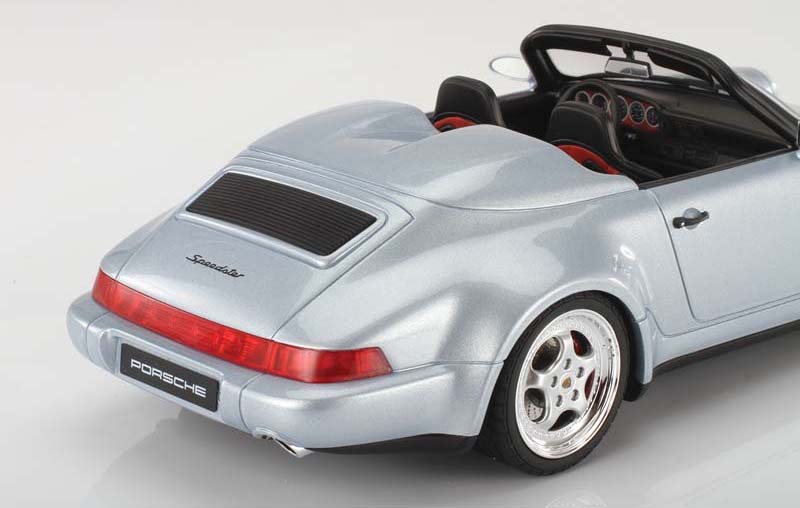
The double-hump tonneau cover and the shortened windscreen are the two defining elements of a 964 Speedster. Just a handful were made with the Turbo-look widebody, making GT Spirit’s choice perfect for collectors.
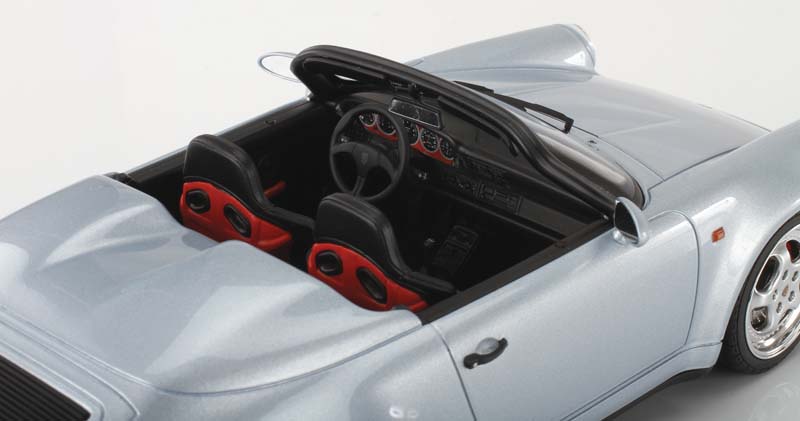
The Speedster interior is identical to the Carrera 2 Cabriolet’s. The optional sport seats at a welcome splash of color and the instrument detail is quite good.
FINAL THOUGHTS
That Porsche even operates such a thing as a factory Sonderwunsch Programm is just awesome, and the fact that it produced such an exquisitely styled vehicle makes it even more so. Porsche is not given to overly dramatic styling cues—the Turbo-look Speedster is about as wild as it gets for Zuffenhausen! It’s flashy but not garish, and because it is Porsche, they made sure the car had the driving dynamics to match. GT Spirit proves yet again that it has a keen eye for selecting model subjects of importance that will be of interest to the discriminating collector—and it delivers those models with equally keen attention to detail.
by Matt Boyd
The post GT Spirit Porsche 911 (964) Speedster Turbo appeared first on Die Cast X.
RAM TRX – looking to take a bite out of Ford’s Raptor 1 Oct 2020 10:14 AM (5 years ago)
The post RAM TRX – looking to take a bite out of Ford’s Raptor appeared first on Die Cast X.
The next Z-car 16 Sep 2020 6:57 AM (5 years ago)
In our upcoming issue we have a giant feature on the 50th Anniversary of the Z-car. It just so happens that last night Nissan did a live unveiling on YouTube of its concept for the upcoming 7th-generation Z (probably to be called the 400Z).
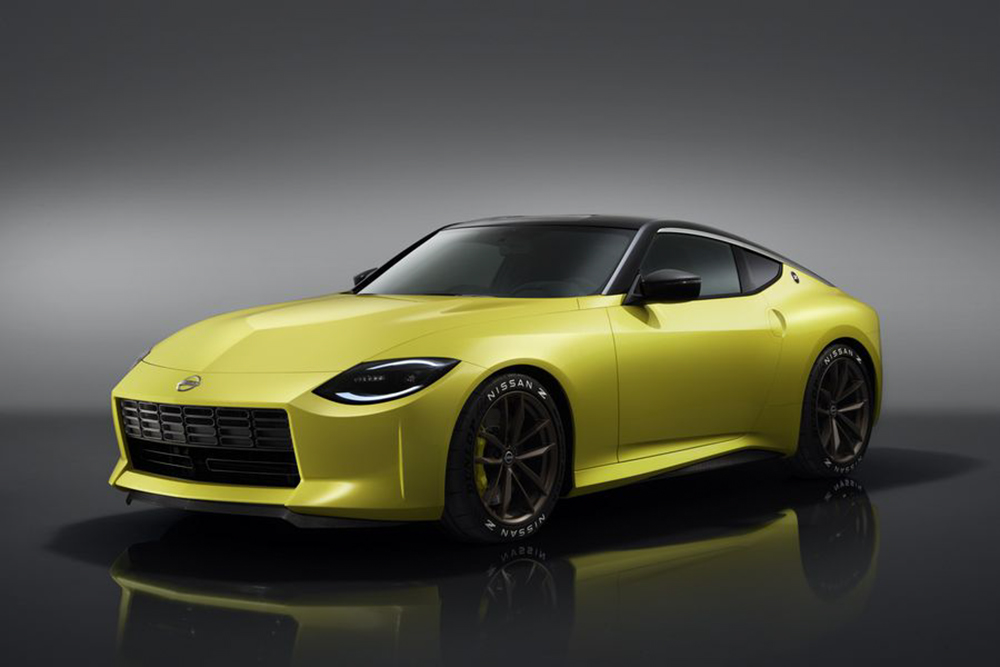
To our eye this concept nicely adapts stylistic elements of the original Z-car into a thoroughly modern shape. It’s a big improvement over the current 370Z which, after 12 years on the market, is starting to look a little stale.
This new Z is anything but stale. Check out the unveil video:
Hemmings did a nice write-up on what is known (and what is assumed) about this upcoming Z. Check that out HERE.
Who would you like to see produce this new Z-car in diecast?
The post The next Z-car appeared first on Die Cast X.
Bengals draft pick Tee Higgins shares his passion for Hot Wheels 27 Apr 2020 10:18 AM (5 years ago)
Tee Higgins has been a member of the Cincinnati Bengals for less than a week. Drafted in the second round of the 2020 draft the wide receiver hasn’t played a single down in the NFL yet, but he’s already a winner. Before he had been drafted — and long before he can expect to receive a penny in contract money — he was already giving back to the community of Greenville, South Carolina with some help from Mattel and the Hot Wheels brand he has loved since he was a kid!
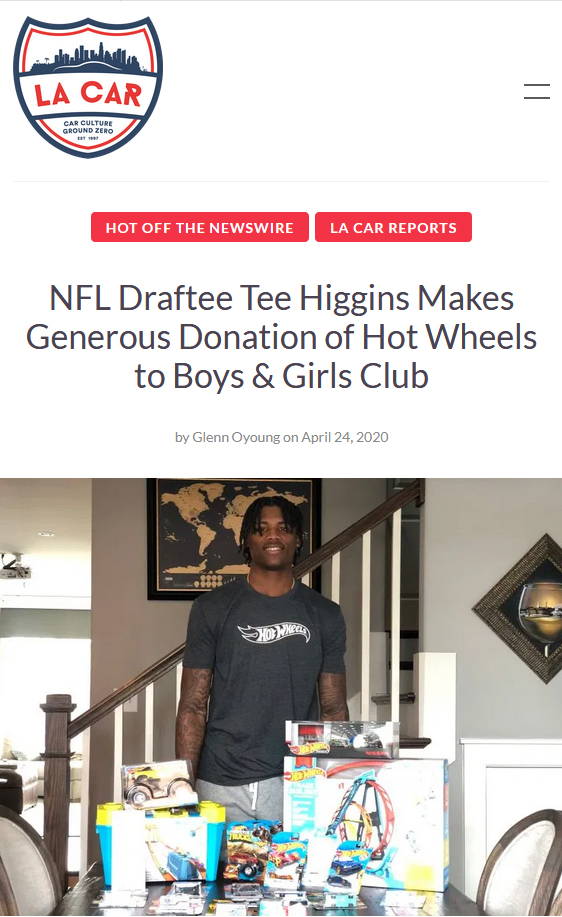 As this cool article by Glenn Oyoung for LACar.com documents (be sure to read the whole article by clicking on image or at the link at bottom of page), Higgins’ love of Hot Wheels traces back to his earliest days in youth football when his aunt would reward him by buying him a Hot Wheels car for each touchdown he scored.
As this cool article by Glenn Oyoung for LACar.com documents (be sure to read the whole article by clicking on image or at the link at bottom of page), Higgins’ love of Hot Wheels traces back to his earliest days in youth football when his aunt would reward him by buying him a Hot Wheels car for each touchdown he scored.
Now he’s in a position to be the one handing out the Hot Wheels, and that’s just what he did for the Greenville Boys & Girls Club. Why Greenville? His college alma mater is in the nearby suburb of Clemson, for whom Higgins caught a touchdown in the 2018 National Championship game, helping deliver the national title for the Clemson Tigers!
So yeah, it seems Tee Higgins has been a winner all along, but because of his generosity we’ll be rooting for him to win some more in his Bengals uniform this fall!
Link to full article HERE
The post Bengals draft pick Tee Higgins shares his passion for Hot Wheels appeared first on Die Cast X.
Head-to-Head Challenge – Round 2 Match-up #1 15 Apr 2020 7:45 AM (5 years ago)
Hey, have you been playing our Die Cast X Head-to-Head Challenge over on Facebook? The idea is simple: we match up pairs of models from a specific theme and you guys vote for the winner of each match-up. We work our way through tournament-style until we come up with a single winner.
The current category is Post-War American Classics (1948-52). Starting with these quarterfinal match-ups we’ve decided to make things a little more interesting by doing video slide shows of the contenders.
Here’s match-up #1:
Top-qualifier Danbury Mint 1948 Chevrolet Fleetline Aerosedan versus Round 1 wildcard Lucky Diecast Tucker 48 “Torpedo.” Watch the slide show and make your pick on Facebook here:
The post Head-to-Head Challenge – Round 2 Match-up #1 appeared first on Die Cast X.
Hot Wheels 2019 Master Set – Hot Wheels TV 13 Apr 2020 12:42 PM (5 years ago)
With so many collectors spending time at home right now its a great opportunity to check out some of the interesting diecast content available on YouTube. Our resident Hot Wheels expert and historian Mike Zarnock has a YouTube channel called Hot Wheels TV which is full of great insights on the most famous name in 1:64, so we figured we’d post links to some of his recent shows so you can check it out.
We’re starting with his unboxing and overview of the 2019 Master Case — a sealed set of literally every Hot Wheels released between January 1 and December 31 2019.
Enjoy as the master breaks down the Master Case!
The post Hot Wheels 2019 Master Set – Hot Wheels TV appeared first on Die Cast X.